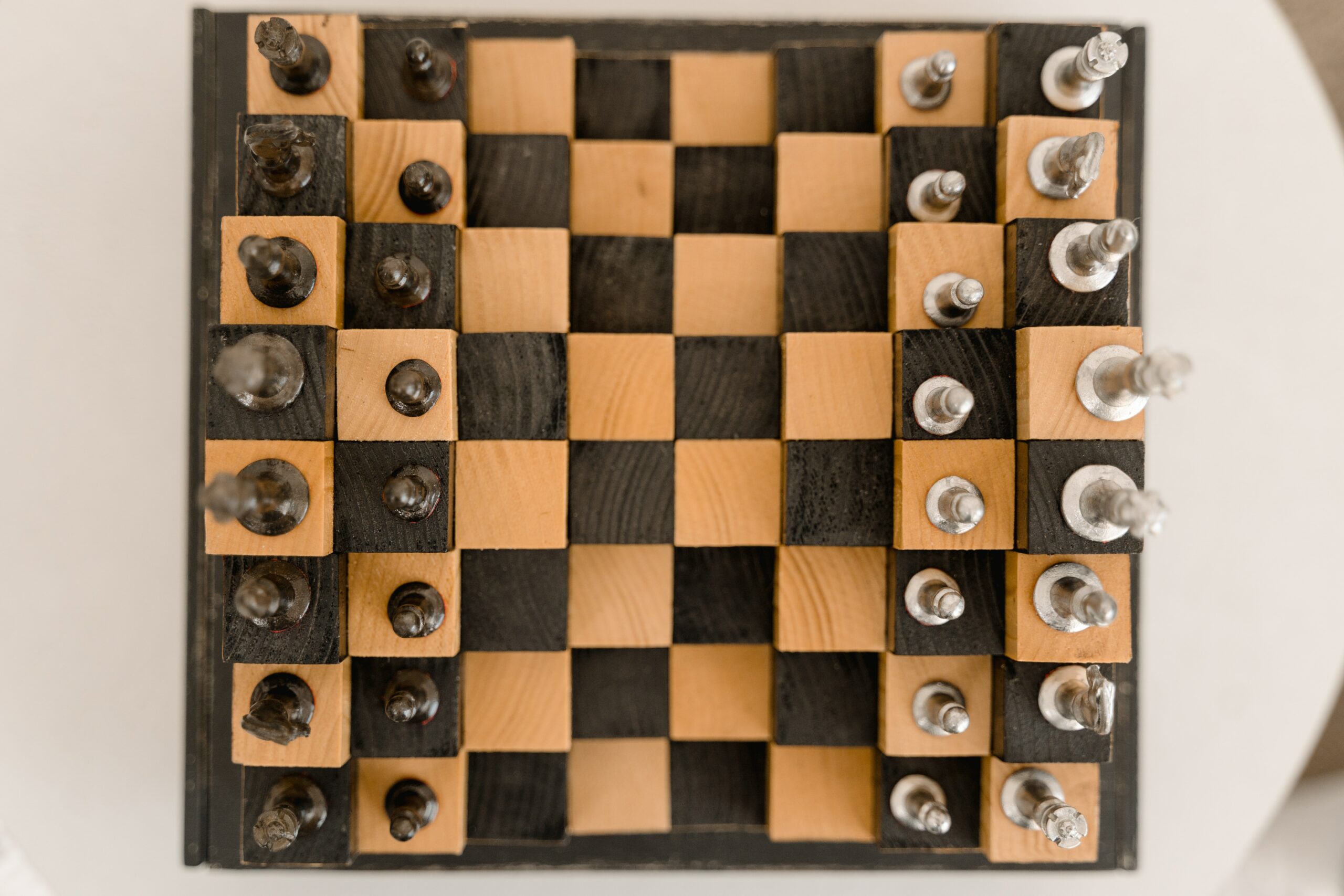Chess is a game of intricate maneuvers and strategic thinking, where every move can make a significant difference in the outcome. Among the arsenal of tactical weapons at a player’s disposal, two common and powerful tactics are the fork and the skewer. These tactical concepts involve placing pressure on the opponent’s pieces, often leading to advantageous gains.
While the fork and the skewer share similarities, they possess distinct characteristics that set them apart. In this article, we delve into the intriguing world of chess tactics, exploring the key differences between a fork and a skewer, and understanding how these maneuvers can be utilized to gain an upper hand on the chessboard.
Whether you are a novice player seeking to enhance your tactical skills or a seasoned chess enthusiast aiming to deepen your understanding, join us as we unravel the mysteries of the fork and the skewer in chess.
What are forks and skewers in chess?
Forks and skewers are two crucial tactical maneuvers in the game of chess. A fork occurs when a single piece simultaneously attacks two or more opponent’s pieces, forcing the opponent to make a difficult choice about which piece to save.
This creates a dilemma and often leads to a material advantage for the attacking player. On the other hand, a skewer involves an attack on an opponent’s piece, which, if moved, exposes a more valuable piece behind it. Skewers can be thought of as a reverse pin, where the attacked piece is of lesser value than the one behind it.
How do forks and skewers differ in terms of tactics?
The primary difference between forks and skewers lies in their objectives. A fork aims to attack multiple pieces simultaneously, putting pressure on the opponent and often leading to material gain. In contrast, a skewer focuses on exploiting the positioning of the opponent’s pieces to target valuable assets, such as the opponent’s king or high-value pieces.
While forks create a forced choice for the opponent, skewers manipulate the line of attack to force the opponent to move the more valuable piece and reveal a vulnerable target.

Are forks and skewers similar in execution?
Forks and skewers share similarities in their execution, as both tactics involve placing pressure on the opponent’s pieces and exploiting their vulnerabilities. Both maneuvers require careful planning and calculation to anticipate the opponent’s responses.
However, the specific positioning and objectives differ. Forks require placing the attacking piece in a position that attacks multiple targets simultaneously, while skewers involve arranging the attacker and the vulnerable target in a line, exploiting the opponent’s need to move the more valuable piece.
Which pieces are commonly used in fork and skewer tactics?
Forks and skewers can be executed by various pieces on the chessboard, but certain pieces are particularly effective in these tactics. The knight is a powerful piece for both forks and skewers due to its unique movement pattern.
Its ability to jump over other pieces allows it to attack multiple targets in a fork or to create a skewer by attacking a valuable piece while simultaneously targeting a less valuable one behind it. Additionally, the queen, rooks, and bishops can also be employed effectively in these tactics, leveraging their range and mobility to create devastating forks or skewers.
Can a fork or skewer lead to a checkmate?
While forks and skewers themselves do not typically lead directly to checkmate, they can significantly contribute to the path of victory. By creating forks or skewers, players often gain a material advantage by capturing an important opponent’s pieces or forcing the opponent’s pieces into unfavorable positions.
This advantage can then be utilized to exert further pressure on the opponent’s king and ultimately lead to a checkmate.
Are there any specific strategies to defend against forks and skewers?
Defending against forks and skewers requires vigilance and strategic thinking. One common defensive strategy is to maintain a strong and cohesive pawn structure, which can limit the mobility of the opponent’s pieces and reduce the likelihood of forks or skewers.
Additionally, careful piece placement, particularly protecting vulnerable pieces, can help minimize the impact of these tactics. Counterattacking or blocking the attacking pieces can also disrupt the opponent’s plans and create counter-threats.
Developing a keen awareness of potential forks and skewers and considering the opponent’s possible moves can be instrumental in defending against these tactics.
How can forks and skewers be used to gain material advantage?
Forks and skewers are potent tactical maneuvers that can be effectively utilized to gain a material advantage in chess. By executing a fork, a player places pressure on the opponent by attacking multiple pieces simultaneously. This forces the opponent to make a difficult decision, often resulting in the loss of one or more valuable pieces.
Similarly, a well-executed skewer exploits the vulnerability of an opponent’s piece by attacking it and simultaneously targeting a more valuable piece behind it. This tactic can lead to the capture of the exposed piece or force unfavorable exchanges, resulting in a material gain for the attacking player.
Can a fork or skewer be used to initiate a winning combination?
While forks and skewers themselves may not directly initiate a winning combination, they are often integral components of such combinations. By gaining a material advantage through forks or skewers, players can create favorable positions, weaken the opponent’s defenses, or expose the opponent’s king to further attacks.
This can set the stage for a winning combination by creating opportunities for checkmates, breakthroughs, or overwhelming material superiority. Therefore, forks and skewers can be instrumental in initiating winning combinations and securing victory in the game.
What are the key differences between a fork and a skewer in chess?
The key differences between a fork and a skewer lie in their objectives and the targets they attack. A fork aims to attack multiple pieces simultaneously, putting the opponent in a difficult position of choosing which piece to save. In contrast, a skewer focuses on attacking a less valuable piece in order to target a more valuable piece behind it.
While forks create a forced choice for the opponent, skewers exploit the line of attack to force the movement of the more valuable piece, exposing the vulnerable target. These distinct characteristics differentiate the two tactics and require players to employ different strategies and calculations to execute them effectively.
Are forks and skewers more effective in the middle game or end game?
Forks and skewers can be effective tactical maneuvers in both the middlegame and endgame stages of chess. In the middlegame, when the board is more crowded and the pieces are still actively engaged in various positions, forks, and skewers can disrupt the opponent’s plans, create imbalances, and lead to significant material gains.
In the endgame, when there are fewer pieces on the board, forks and skewers can play a crucial role in exploiting positional weaknesses, targeting important pawns or valuable remaining pieces, and facilitating the path to victory. Ultimately, the effectiveness of forks and skewers depends on the specific positions and dynamics of the game.

Are there any notable historical examples of forks and skewers in chess?
Chess history is replete with notable examples of forks and skewers that have shaped the outcome of games. One famous example is the “Opera Game” played between Paul Morphy and the Duke of Brunswick and Count Isouard in 1858. In that game, Morphy executed a stunning double bishop sacrifice, leading to a devastating fork that ultimately secured his victory.
Another notable example is the game between Anatoly Karpov and Veselin Topalov in 1994, where Karpov employed a powerful skewer tactic involving his rook and bishop, which led to a material advantage and contributed to his win. These historical examples showcase the significance and impact of forks and skewers in competitive chess.
| Forks | Skewers | |
|---|---|---|
| Definition | A tactic that simultaneously attacks two or more pieces | A tactic that targets a valuable piece through another piece |
| Purpose | To create material imbalance or positional advantage | To force the opponent’s piece to move and expose a more valuable piece |
| Execution | Simultaneously attacking the target pieces with a single piece | Attacking a piece that obstructs the path to a valuable piece |
| Commonly Used Pieces | Knight, bishop, queen | Bishop, rook, queen |
| Checkmate Potential | Can indirectly lead to checkmate by exploiting the opponent’s weakened position | Can’t directly lead to checkmate, but can create advantageous positions for a potential checkmate |
Can forks and skewers be used in positional play?
While forks and skewers are commonly associated with tactical play, they can also be strategically employed in positional play. In positional chess, forks and skewers can be used to create imbalances, disrupt the opponent’s coordination, or force favorable trades. By leveraging the threat of a fork or a skewer, players can manipulate the positioning of the opponent’s pieces, weaken their pawn structure, or open up lines of attack.
Additionally, the potential for forks and skewers can influence piece placement and guide long-term plans. Therefore, these tactical motifs have a role to play in both tactical and positional aspects of the game.
Are there any advanced tactics involving forks and skewers?
In addition to basic forks and skewers, there are advanced tactics that involve these tactical motifs. For example, players can employ double attacks, also known as double forks, where a single piece simultaneously attacks more than two opponent’s pieces, increasing the complexity and difficulty of the opponent’s response.
Another advanced tactic is the “intermezzo” or “in-between move,” where a player executes a fork or skewer as an intermediate move in a sequence of moves, capitalizing on the opponent’s limited options. These advanced tactics require deeper calculations and strategic understanding to execute successfully.
How can one anticipate and counter forks and skewers?
Anticipating and countering forks and skewers require a combination of vigilance, calculation, and strategic planning. Players can develop a sense of potential forks and skewers by carefully assessing the positioning of the opponent’s pieces and evaluating the vulnerabilities of their own pieces.
Maintaining a strong pawn structure, protecting vulnerable pieces, and practicing good piece coordination can help minimize the impact of these tactics. Additionally, actively considering the opponent’s possible moves and maintaining flexibility in piece placements can aid in countering forks and skewers effectively.

What are the limitations and weaknesses of forks and skewers?
Although forks and skewers can be powerful tactics, they also have certain limitations and weaknesses. One limitation is that they often require favorable positioning and coordination of pieces to be executed effectively. If the opponent’s pieces are well-coordinated and positioned, it can be challenging to create opportunities for forks or skewers.
Moreover, skilled opponents may anticipate and defend against these tactics, making them less effective. Additionally, forks and skewers can sometimes result in a temporary material gain but leave the player vulnerable to counterattacks or strategic disadvantages. Therefore, while forks and skewers are valuable tools, they need to be employed judiciously and in conjunction with other strategic considerations.
Wrapping Up
In the complex world of chess tactics, the fork and the skewer stand out as powerful maneuvers that can significantly impact the outcome of a game. While both tactics involve placing pressure on the opponent’s pieces, they possess distinct characteristics that set them apart. A fork targets multiple pieces simultaneously, forcing the opponent into a difficult choice, often resulting in material advantage.
On the other hand, a skewer exploits the positioning of the opponent’s pieces, attacking a less valuable piece to expose a more valuable one behind it. Understanding the key differences between these tactics is crucial for chess players seeking to enhance their strategic prowess. By mastering the art of forks and skewers, players can gain a material advantage, initiate winning combinations, and exploit the vulnerabilities of their opponents.
However, it is important to note that forks and skewers are not without limitations and weaknesses, and skilled opponents can anticipate and counter these tactics. Thus, a well-rounded chess player must approach forks and skewers with a strategic mindset, incorporating them into their overall game plan while considering the broader positional aspects of the board.
Through careful analysis, practice, and creativity, players can harness the power of forks and skewers to navigate the intricate landscape of chess and emerge victorious.




